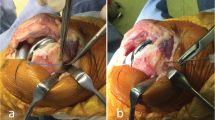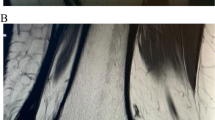Abstract
Purpose
The ratio of femoral width and distance from medial epicondyle to joint line helps estimate the femoral joint line position from femoral width. The approximately radial position of the medial epicondyle on femoral condyle spheres is probably responsible for this relationship, The adductor tubercle approximately lies diametrically opposite to the joint line on condylar sphere. Then, a linear correlation could also exist between the femoral width and distance of adductor tubercle to joint line and is the purpose of the current study.
Methods
Femoral width, along with the distance to joint line from the medial epicondyle, the adductor tubercle and fibular pole, was measured on 110 standard antero-posterior knee radiographs. Correlation between femoral width and these measurements was evaluated. The individual ratio of FW with adductor tubercle joint line, medial epicondyle joint line and fibula joint line was calculated using linear regression analysis. Intra-observer and inter-observer reliability was assessed.
Results
Linear correlation was found between femoral width and distance of adductor tubercle to joint line (r = 0.83). It was more reliable than the correlation between femoral width and distance from medial epicondyle to joint line (r = 0.52). Inter-observer repeatability was better for distance from adductor tubercle to joint line than for distance from medial epicondyle to joint line.
Conclusions
We conclude that adductor tubercle can be used as a morphologic landmark to determine the knee joint line position, because a linear correlation between femoral width and distance from the adductor tubercle to the joint line was found.
Level of evidence
Case series, Level IV.




Similar content being viewed by others
References
Barnett AJ, Howells NR, Burston BJ, Ansari A, Clark D, Eldridge JD (2012) Radiographic landmarks for tunnel placement in reconstruction of the medial patellofemoral ligament. Knee Surg Sports Traumatol Arthrosc. doi:10.1007/s00167-011-1871-8
Bellemans J (2004) Restoring the joint line in revision TKA: does it matter? Knee 11:3–5
Christiansen SE, Jacobsen BW, Lund B, Lind M (2008) Reconstruction of the medial patellofemoral ligament with gracilis tendon autograft in transverse patellar drill holes. Arthroscopy 24:82–87
Figgie HE 3rd, Goldberg VM, Heiple KG, Moller HS III, Gordon NH (1986) The influence of tibial-patellofemoral location on function of the knee in patients with the posterior stabilized condylar knee prosthesis. J Bone Joint Surg Am 68:1035–1040
Griffin FM, Math K, Scuderi GR, Insall JN, Poilvache PL (2000) Anatomy of the epicondyles of the distal femur: MRI analysis of normal knees. J Arthroplasty 15:354–359
Havet E, Gabrion A, Leiber-Wackenheim F, Vernois J, Olory B, Mertl P (2007) Radiological study of the knee joint line position measured from the fibular head and proximal tibial landmarks. Surg Radiol Anat 29:285–289
Hoeffel DP, Rubash HE (2000) Revision total knee arthroplasty: current rationale and techniques for femoral component revision. Clin Orthop Relat Res 380:116–132
Jacobi M, Reischl N, Bergmann M, Bouaicha S, Djonov V, Magnussen RA (2012) Reconstruction of the medial patellofemoral ligament using the adductor magnus tendon: an anatomic study. Arthroscopy 28:105–109
Laskin RS (1998) Management of the patella during revision total knee replacement arthroplasty. Orthop Clin North Am 29:355–360
Laskin RS (2002) Joint line position restoration during revision total knee replacement. Clin Orthop Relat Res 404:169–171
Lind M, Jakobsen BW, Lund B, Christiansen SE (2008) Reconstruction of the medial patellofemoral ligament for treatment of patellar instability. Acta Orthop 79:354–360
Partington PF, Sawhney J, Rorabeck CH, Barrack RL, Moore J (1999) Joint line restoration after revision total knee arthroplasty. Clin Orthop Relat Res 367:165–171
Romero J, Seifert B, Reinhardt O, Ziegler O, Kessler O (2010) A useful radiologic method for preoperative joint-line determination in revision total knee arthroplasty. Clin Orthop Relat Res 468:1279–1283
Servien E, Viskontas D, Giuffrè BM, Coolican MRJ, Parker DA (2008) Reliability of bony landmarks for restoration of the joint line in revision knee arthroplasty. Knee Surg Sports Traumatol Arthrosc 16:263–269
Stiehl JB, Abbott BD (1995) Morphology of the transepicondylar axis and its application in primary and revision total knee arthroplasty. J Arthroplasty 10:785–789
Acknowledgments
There was no external funding for this study or for any of the authors in relation to this study.
Author information
Authors and Affiliations
Corresponding author
Rights and permissions
About this article
Cite this article
Iacono, F., Lo Presti, M., Bruni, D. et al. The adductor tubercle: a reliable landmark for analysing the level of the femorotibial joint line. Knee Surg Sports Traumatol Arthrosc 21, 2725–2729 (2013). https://doi.org/10.1007/s00167-012-2113-4
Received:
Accepted:
Published:
Issue Date:
DOI: https://doi.org/10.1007/s00167-012-2113-4




